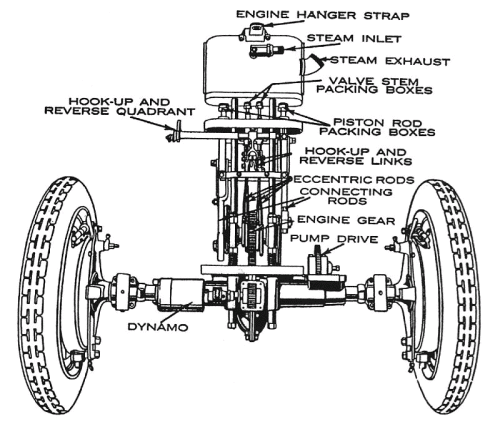|
The heart of the Stanley Motor Carriage is its steam engine. The first Stanley cars had the steam engine mounted within the car's body frame with a chain drive to the rear axle similar to other manufacturers of the era. After the Stanley twins sold the business to Locomobile in 1899 the use of chain drive continued. In 1901 when the Stanley twins took up making steam cars once again they employed a chain drive as well. Patent infringement issues with Locomobile forced the twins to figure out another way to connect the steam engine's power with the rear axle. They decided to direct mount the steam engine to the rear axle. This solution turned out to be the perfect answer. A significant amount of the car's weight now moved to the rear axle thus not adding to the car's sprung weight. More importantly with a direct gear connection between the engine and rear axle all the mechanical problems associated with proper chain tensioning as the suspension moved, chain lubrication and alignment, and keeping dirt and debris from getting caught in the chain were eliminated. Direct connection of the steam engine to the rear axle was an advantage that helped Stanley become a dominant steam car manufacturer.
All Stanley engines are two cylinder, double acting with Stephenson valve gear (D slide valves). Stanley steam carriage horsepower ratings are not based on engine power but on the boiler steaming capacity in horsepower. Thus the most common Stanley cars were rated at 10, 20, or 30 horsepower. Once Stanley moved to building only condensing steam cars (where the exhaust steam was condensed and the water reused) all cars were 20 horsepower cars. In reality Stanley steam engines had the capability to produce a lot more horsepower than the horsepower rating of the boiler. A 20-horsepower engine could develop approximately 125 horsepower. The problem arises with the engine developing 125 horsepower the boiler is required to generate a large volume of 550 PSIG steam pressure continuously. Unfortunately the boiler isn't capable of generating this volume of steam and thus the horsepower of the engine drops off as the steam pressure from the boiler drops. This isn't a problem since a Stanley roughly requires about 15 horsepower on a level road to travel along at 30 MPH. Thus it is easy to drive along at 30 MPH and maintain 550 PSIG steam pressure because the amount of steam consumed is less than what the boiler is capable of generating. However if you increase the speed of the vehicle you need more horsepower and thus soon the engine will require more horsepower than the boiler can generate and the result is the steam pressure drops and the engine horsepower drops. The key to driving the Stanley is to balance the average power the engine requires against the maximum steaming capability the boiler has to deliver. Climbing a grade requires more horsepower and drops the boiler's pressure. But when you're coasting down a grade no horsepower is required by the engine and thus the boiler can catch up. So the trick to driving a Stanley is to manage the horsepower needed to drive the car against what the boiler is capable of delivering. What is perhaps most unique about the Stanley engine is its lightweight construction. Steam locomotive and steam traction engines were generally massive in construction. Weight was a benefit in those applications for traction. Weight in a car is a penalty. Thus the Stanley twins had to design a steam engine that was reliable yet lightweight. Along the left side of this window are a series of photos showing different aspects of the Stanley engine. The photos in each of these series are of an engine that had just completed a full rebuilding (new rings, crank bearings, etc.). Click on a photo to see the series of pictures associated with that photograph. Please note that there are 4 to 6 photos associated with each series and thus each of the panels of photos will take about 2 minutes to load with a 56K modem. For those with an interest in computer simulation of a steam engine, an excellent program is provided as reference. Finally, six videos are provided showing the steam engine, winker, and pumps in operation. |

